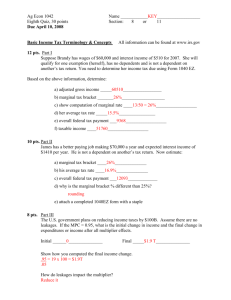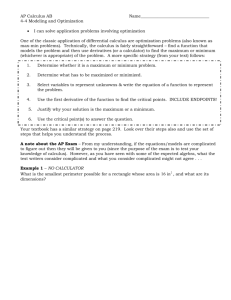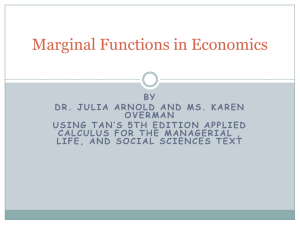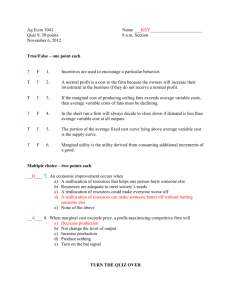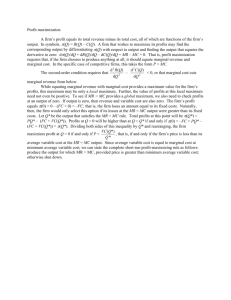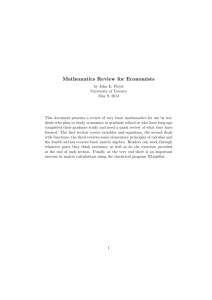4.4 Applications of Optimization to Marginal
advertisement
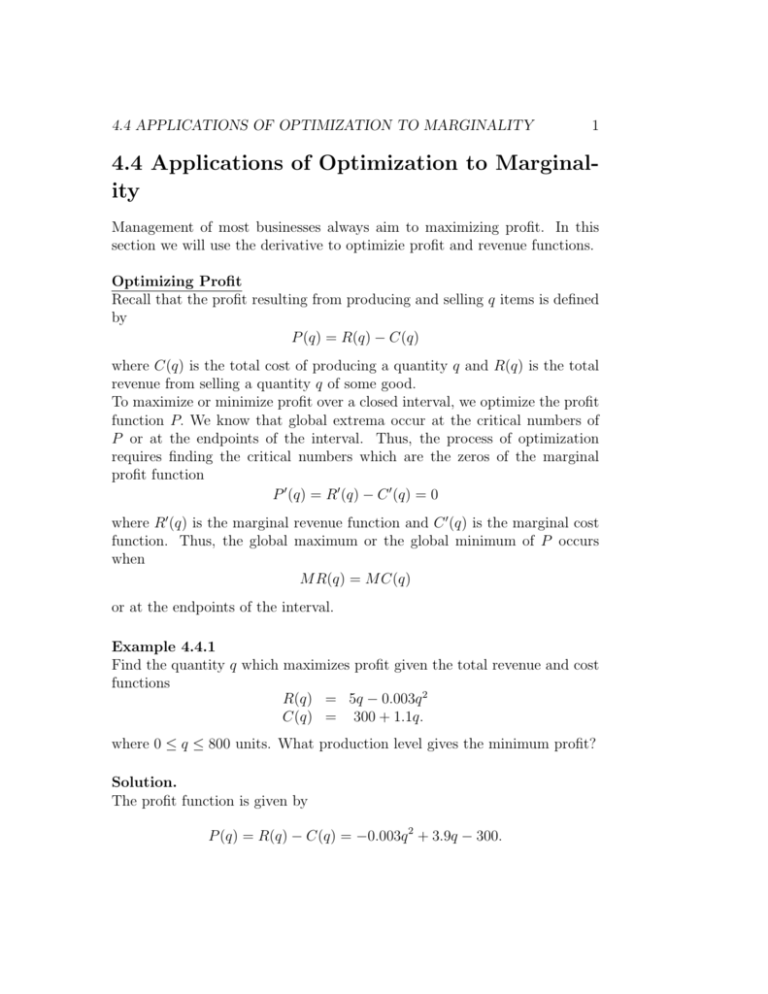
4.4 APPLICATIONS OF OPTIMIZATION TO MARGINALITY 1 4.4 Applications of Optimization to Marginality Management of most businesses always aim to maximizing profit. In this section we will use the derivative to optimizie profit and revenue functions. Optimizing Profit Recall that the profit resulting from producing and selling q items is defined by P (q) = R(q) − C(q) where C(q) is the total cost of producing a quantity q and R(q) is the total revenue from selling a quantity q of some good. To maximize or minimize profit over a closed interval, we optimize the profit function P. We know that global extrema occur at the critical numbers of P or at the endpoints of the interval. Thus, the process of optimization requires finding the critical numbers which are the zeros of the marginal profit function P 0 (q) = R0 (q) − C 0 (q) = 0 where R0 (q) is the marginal revenue function and C 0 (q) is the marginal cost function. Thus, the global maximum or the global minimum of P occurs when M R(q) = M C(q) or at the endpoints of the interval. Example 4.4.1 Find the quantity q which maximizes profit given the total revenue and cost functions R(q) = 5q − 0.003q 2 C(q) = 300 + 1.1q. where 0 ≤ q ≤ 800 units. What production level gives the minimum profit? Solution. The profit function is given by P (q) = R(q) − C(q) = −0.003q 2 + 3.9q − 300. 2 The critical numbers of P are the solutions to the equation P 0 (q) = 0. That is, 3.9 − 0.006q = 0 or q = 650 units. Since P (0) = −$300, P (800) = $900 and P (650) = $967.50, the maximum profit occurs when q = 800 units and the minimum profit(or loss) occurs when q = 0, i.e. when there is no production Example 4.4.2 The total revenue and total cost curves for a product are given in Figure 4.4.1. Figure 4.4.1 (a) Sketch the curves for the marginal revenue and marginal cost on the same axes. Show on this graph the quantities where marginal revenue equals marginal cost. What is the significance of these two quantities? At which quantity is profit maximum? (b) Graph the profit function P (q). Solution. (a) Since R is a straight line with positive slope, its derivative is a positive constant. That is, the graph of the marginal revenue is a horizontal line at some value a > 0. Since C is always increasing, its derivative M C is always positive. For 0 < q < q3 the curve is concave down so that M C is decreasing. 4.4 APPLICATIONS OF OPTIMIZATION TO MARGINALITY 3 For q > q3 the graph of C is concave up and so M C is increasing. Thus, the graphs of M C and M R are shown in Figure 4.4.2. Figure 4.4.2 According to the graph, marginal revenue equals marginal cost at the values q = q1 and q = q2 . So maximum profit occurs either at q1 , q2 or at the endpoints. Notice that the production levels q1 and q2 correspond to the two points where the tangent line to C is parallel to the tangent line to R. Now, for 0 < q < q1 we have M R < M C so that P 0 = M R − M C < 0 and this shows that P is decreasing. For q1 < q < q2 , M R > M C so that P 0 > 0 and hence P is increasing. So P changes from decreasing to increasing at q1 which means that P has a minimum at q1 . Now, for q > q2 we have that M R < M C so that P 0 < 0 and P is decreasing. Thus, P changes from increasing to decreasing at q2 so q2 is a local maximum for P. So maximum profit occurs either at the endpoints or at q2 . Since profit is negative for q < q3 and q > q4 , the profit is maximum for q = q2 . (b) The graph of P is shown in Figure 4.4.3. 4 Figure 4.4.3 Optimizing Revenue Example 4.4.3 The demand equation for a product is p = 45 − 0.01q. Write the revenue function as a function of q and find the quantity that maximizes revenue. What price corresponds to this quantity? What is the total revenue at this price? Solution. The revenue function is given by R(q) = pq = 45q −0.01q 2 . This is a parabola that opens down so its vertex is the global maximum. The maximum then occurs at the critical number of R(q). That is, at the solution of R0 (q) = 0 or 45 − 0.02q = 0. Solving for q we find q = 2250 units. The maximum revenue is R(2250) = $50, 625. The unit price in this case is p = 45 − 0.01(2250) = $22.50

